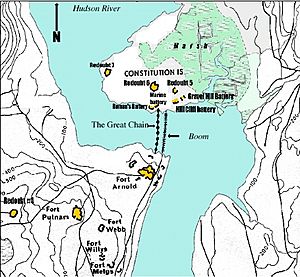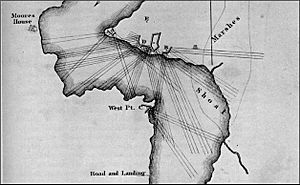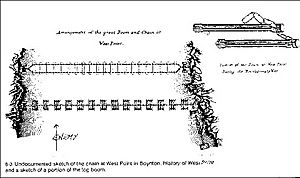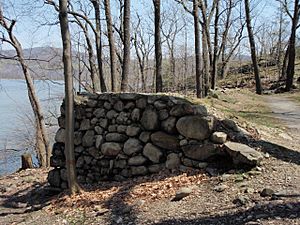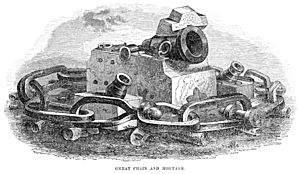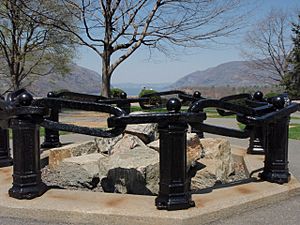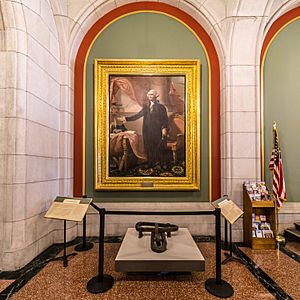Hudson River Chains facts for kids
The Hudson River Chains were giant barriers built across the Hudson River during the American Revolutionary War. American soldiers, part of the Continental Army, created these chains between 1776 and 1778 near West Point, New York. Their main goal was to stop British warships from sailing up the river and attacking American towns or cutting off New England from the other colonies.
The first chain was destroyed by British forces in October 1777. But the most important and successful one was the Great Chain. It was built in 1778 and used until the war ended in 1782. Americans also tried other barriers called chevaux-de-frise. One was between Fort Washington in Manhattan and Fort Lee in New Jersey. Another was started near Pollepel Island but was later abandoned.
Contents
Why the Hudson River Was Important
Even before the war officially started in 1775, both the Americans and the British knew the Hudson River was super important. Controlling the river meant controlling a key pathway. If the British controlled it, they could split the American colonies in half.
The Americans wanted to block British ships. They planned to attack vessels with cannons from both sides of the river. In 1776, some American leaders, including Henry Wisner, suggested putting chains in important spots along the Hudson.
American forces eventually built three main obstacles:
- A chevaux-de-frise (underwater logs) between Fort Washington and Fort Lee in 1776.
- A chain and boom at the entrance to the Hudson Highlands, near Fort Montgomery, in 1776–1777.
- The Great Chain between West Point and Constitution Island in 1778.
A fourth barrier near Pollepel Island was started but never finished. The first two barriers were quickly captured by the British. However, the Great Chain, which was the biggest project, was put in place every spring until the war ended. The West Point area was chosen because the river there is narrow and curvy. This made ships slow down, making them easier targets for American cannons.
Underwater Logs at Fort Lee and Fort Washington (1776)
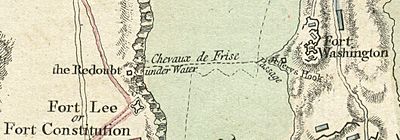
In 1776, the American army built a barrier of logs underwater. These logs were placed between Fort Washington in Manhattan and Fort Lee in New Jersey. The idea was for the logs to pierce and sink any British ships that tried to sail over them. The Americans left a secret opening for their own ships to pass through.
However, the British found out about this opening from a local person. They managed to pass through the barrier several times. The British then captured both Fort Washington and Fort Lee in November 1776. This meant the barrier was now in their hands. This didn't change much, though, because the American Navy didn't have large ships like the British.
The Fort Montgomery Chain (1776–1777)
In 1776, another chain and boom (a floating barrier) were placed across the river. This one stretched from Fort Montgomery on the west bank to Anthony's Nose on the east bank. Captain Thomas Machin led this project. In November 1776, a weak link in the chain broke because of the strong river current. This showed how difficult it was to chain the Hudson River. The chain was repaired and put back in place.
On October 6, 1777, the British captured Fort Montgomery and Fort Clinton. After that, they took apart the chain. With the river now open, British ships sailed upriver to Kingston, which was then the capital of New York State. They burned most of Kingston to the ground.
Even though the chain was captured, Governor George Clinton was encouraged. The British had never tried to sail their ships through the chain. This made him believe that blocking the river was a good idea. After Captain Machin recovered from his battle wounds, he started working on the much stronger Great Chain at West Point.
Unfinished Barrier at Pollepel Island (1776–1777)
Another barrier of underwater logs was planned across the Hudson River. It was meant to be between Plum Point and Pollepel Island, north of West Point. However, this defense was never fully finished. Its importance faded once the Great Chain was completed at West Point the next year.
The Great Chain (1778–1782)
In the spring of 1778, a very heavy chain was stretched across the Hudson River. It went from West Point to Constitution Island. This chain was supported by huge floating log rafts. Its purpose was to stop British ships from moving north of West Point. About 100 yards downstream, a second log boom was placed. This boom looked like a ladder and was designed to absorb the impact if a ship tried to crash through the chain.
The Hudson River at West Point has strong currents and changing tides. The winds are often not good for sailing. Plus, the river is narrow and has a sharp "S-curve" there. This meant large ships had to zig-zag to get through. American cannons were placed in forts and batteries on both sides of the river. They could attack British ships when they slowed down because of the chain.
The Great Chain was built in six weeks at the Sterling Iron Works in Warwick. The iron links came from another factory in Ringwood, New Jersey. When finished, the chain was about 600 yards long. Each iron link was about 2 feet long and weighed between 140 and 180 pounds. The links were taken to New Windsor, put together, and then floated down the river to West Point on logs in late April.
The entire chain, including swivels and anchors, weighed 65 tons. To keep it floating, logs were cut into 16-foot pieces. These logs were waterproofed and joined together in groups of four to make rafts. Short sections of the chain (10 links) were attached across each raft. These sections were then joined to create one continuous barrier of chains and rafts.
Captain Thomas Machin, who had worked on the Fort Montgomery chain, led the installation. The chain was put across the river on April 30, 1778. Both ends were anchored to large log boxes filled with rocks. The West Point side was protected by the Chain Battery, and Constitution Island was protected by the Marine Battery. A system of pulleys, ropes, and anchors in the middle of the river helped adjust the chain's tightness. This helped it handle the river's current and changing tides. Every winter until 1783, the chain was removed to protect it from ice. It was then reinstalled each spring.
The British never tried to break through the Great Chain. Even though Benedict Arnold (who secretly worked for the British) claimed a ship could break it, they never attempted it. A Polish engineer named Thaddeus Kościuszko, who helped the Americans, also helped design the defenses at West Point.
Memorials
After the war, some parts of the Great Chain were saved. The rest was melted down at a factory near Cold Spring, New York. A saved part was first shown at the West Point military base, along with a captured cannon.
Today, thirteen links of the Great Chain are displayed at Trophy Point at West Point. There is one link for each of the Thirteen Colonies. A swivel and clevis (parts of the chain) are also there. The West Point Museum takes care of this exhibit. A section of the log boom, found in the river in 1855, is displayed at Washington's Headquarters State Historic Site in Newburgh, New York.
Two links of the original chain are also at Raynham Hall in Oyster Bay, New York. This was the home of Robert Townsend, who was a spy for George Washington. Sadly, some people later sold fake chain links to collectors and museums.
Two links of the original chain are also displayed under a portrait of George Washington in the New York State Capitol building.


